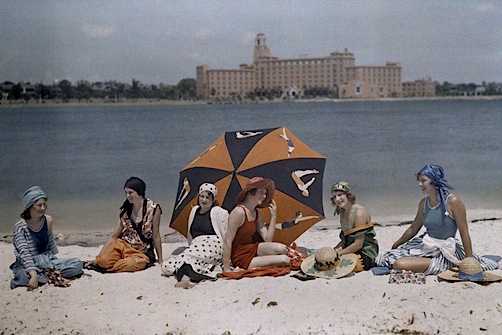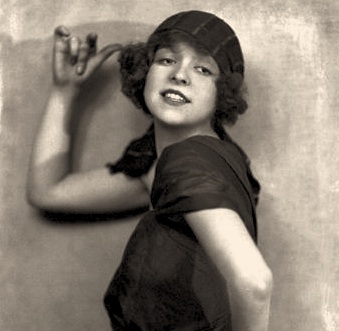Two Surprising Innovations that Heralded the Roaring Twenties
Dan Bryan, March 9 2012
 Women in St. Petersburg, Florida display the fashions of the 1920s.
Women in St. Petersburg, Florida display the fashions of the 1920s.The smallest of innovations can often have the greatest of effects.
Though neither was "invented" per se in the 1910s, the advent of the sanitary napkin and the brassiere would have an outsized effect on women's fashion and culture during the Roaring Twenties.
Five times as absorbent as the normal bandage
Kimberly Clark created a new type of bandage to meet the needs of the Great War. "Celu-cotton", manufactured primarily from cellulose (i.e. wood pulp), was found to be five times as absorbent as the normal bandage. Red Cross nurses put their minds to work and started using them as sanitary napkins, and they brought back to the States a knowledge of their effectiveness. Kimberly-Clark began selling the new product in 1921.
Before this time, being "on the rag" was a much more literal description of the menstrual cycle. Said rags were washed and reused each month, and this practice continued for many years among women with less money or more frugality.
A new, lighter undergarment
Mary Phelps Jacob had large breasts. She was preparing to attend a debutante ball one evening in 1910, and was faced with a problem of some concern. The corset she was wearing pushed out from underneath her dress, and there was little time to rectify the situation. So she threw the corset to the side and, with her maid, fashioned a much leaner substitute out of two handkerchiefs, some ribbon and some cord. Other women loved the new device.
As with any great invention, arguments rage over whether this was the "first" bra or not. The implications of the bra's spread in society however, are beyond dispute. Undergarments shrank in size and increased and comfort, and this allowed for leaner, trimmer clothes to be worn on the outside.
The Great War served as the true death blow to the era of the corset. Needing the steel for military production the government advised women to stop wearing corsets, and when the war ended many of them never went back.
In place of the corset, women's undergarments became lighter and less restrictive. This transition took place throughout the 1920s. Bras competed with bustiers. "Step-ins" and bloomers took the place of petticoats. Rayon was used more, and cotton less (exacerbating the economic problems of southern agriculture and of textiles).
Without petticoats and restrictive steel corsets, women were free to wear thinner, lighter, and more comfortable dresses. Whether it was a coincidence or not, a great change in fashion and culture ensued.
Rising hemlines and scandalous visions of the knee
The first whispers of disapproval started when hemlines rose above the ankle. Then they went a couple inches higher, and the fashion arbiters said surely it would stop. But by the early 1920s, the most adventurous of women were wearing skirts that barely even covered their knees.
As the skirts got shorter, so too did the hairstyles. Whereas short hair on a women had classically been viewed as unacceptable, now it was entirely in vogue. Blouses became thinner and the sleeves abbreviated. At night, during the summer months, young women would sometimes be seen with bare arms. On the beach, swimsuits were even more revealing.
 Clara Bow exemplified the new look of the 1920s.
Clara Bow exemplified the new look of the 1920s.The colors got brighter as well. The black dresses which had been so dominant now became merely part of the rotation, mixed with reds and blues and greens and yellows.
Flapper was the term that came to describe these new young girls. Like many terms of this type, its origins are varied and disputed, but it caught on and become one of those iconic labels that the story of an entire era can be built around.
However, it wasn't just the "flapper" crowd that embraced the new fashions. Though they may have kept a couple more inches on each end, many typical, mainstream women also wore their skirts and their hair much shorter than they would have even three or four years earlier. Setting aside any fashion statement involved, the physical comfort of the new style was too enticing to pass up, and the rise of the sanitary napkin made layer upon layer of undergarments a little more unnecessary during those certain periods of the month.
Skepticism, hedonism, and Freudian adulation of Freud
What were the values embraced by this new group of women? Skepticism and disdain seemed to be near the top of the list. After all, it was the the established wisdom and system that had produced The Great War, killing 9 million people to no obvious purpose.
What some called hedonism was not far behind -- with Prohibition proving to be a ludicrous goal for the middle and upper classes. Hard liquor was favored over beer and wine, since it was more easily smuggled. Gin was the single most common drink consumed, and with harder liquor came less restrained behavior.
Finally, there was an open-mindedness to science and to new ideas that could be called irreligious in many cases. An adulation of Sigmund Freud was almost mandatory. After all, he had single-handedly solved the mysteries of psychological development and human sexuality. He most likely never had wider acclaim in the United States than he enjoyed in the 1920s. It was an environment that made it possible for college girls to say things like the following -- with a straight face:
"The man you marry will certainly have an Oedipal fixation on you, which will be all right if it isn't joined to an incest complex."
Since disregarding one's own sexuality was a sure road to the accumulation of psychological problems, it was only right that girls and boys should grow to enjoy each other's company a little more than had been traditional. Late night auto rides, often with a flask in hand, helped out in this regard. Preachers railed against the evil side effects of the automotive industry, but their sermons were of little concern to the flapper set.
Sex?
Making out was commonplace. There were even parties devoted to that purpose, held late at night in hotel rooms. How far this libertine philosophy extended itself is impossible to guess. There seemed to be a general agreement that more young women than ever before were compromising their virtue. Some anonymous surveys claimed that a third of the young women in that time had sexual experience before they got married. If true, this would have certainly been a huge increase from the early 1900s, when vigilant supervision and constant sobriety suppressed such notions.
Contraceptives themselves had long been illegal under the Comstock Act, but the rich and well-connected could get ahold of them. Noah Slee -- oil magnate and husband to Margaret Sanger -- purchased massive quantities of diaphragms in Germany, shipped them to Canada, and smuggled them over the border in oil drums. A more pedestrian means of birth control was to douche one's self with Lysol or a similar substance.
Abortion was illegal in every state, though widely practiced. Dorothy Brown estimated that a million abortions occurred each year during the 1920s, but hard statistics don't exist. What is certain is that quality varied widely, depending upon one's connections and financial resources. Under the table abortions were very unsafe in this era, and many women died from the procedure.
Disapproval of the new woman, from many angles
There were quite a few people who were disturbed by these new trends. Defenders of moral tradition still made up a great proportion of society, and many of them were quite appalled. Some had spent decades advocating Prohibition, and to see hordes of respectable young women make a mockery of that amendment was not something taken lightly. They also thundered against the insidious cultural and literary influences of the youth, in terms of music and dance. The complaints in this regard originated as so many of them did from the preacher on the pulpit, and the elder woman of the social club.
Another group was perturbed for entirely different reasons. The Suffragists had worked for about as long as the Prohibitionists before their victory was delivered. Now it seemed that, almost as soon as the vote was granted, an entire generation of young women sprang up who seemed to care less about their civic responsibility. They acted cavalier about the efforts of the previous generation, mocked the attire of the Suffragists in word and deed, and viewed the unmarried older women with just a little bit of pity. As the Suffragists tried to muster support for new causes, many of the younger women argued that feminism was no longer necessary.
In any case, the flapper set had more than won the battle. They had acted as they wished, influenced many older and more moderate women to follow their lead (or a more restrained version of it), and nobody had the power to stop them. The changes from the 1910s were irrevocable.
Recommendations/Sources
- Sex and the Moderns (contemporary article)
- New Freedom and the Girls (contemporary article)
- 1920s Women's Fashion
- Gail Collins - America's Women: 400 Years of Dolls, Drudges, Helpmates, and Heroines (P.S.)
- Dorothy Brown - Setting a Course: American Women in the 1920s (American Women in the Twentieth Century)
- Frederick Lewis Allen - Only Yesterday: An Informal History of the 1920s
